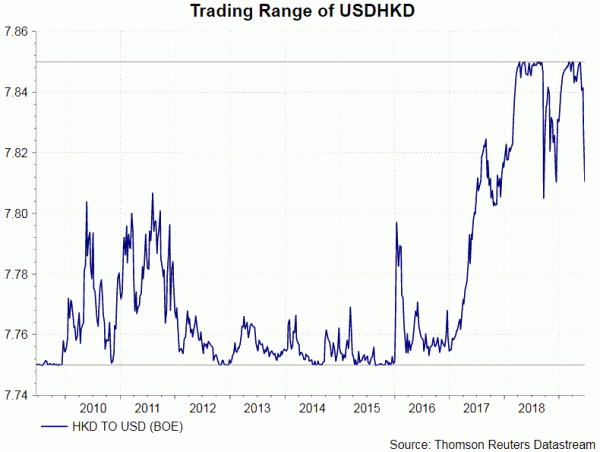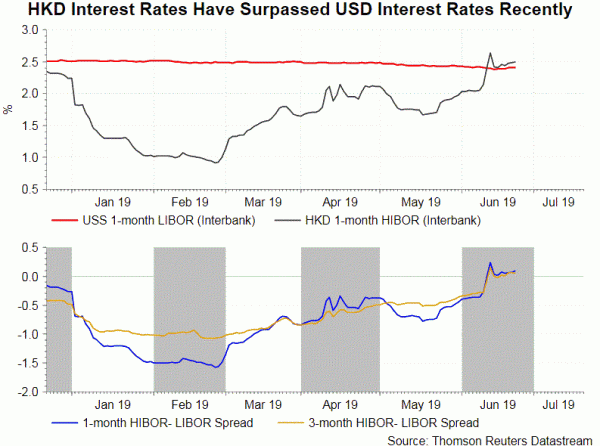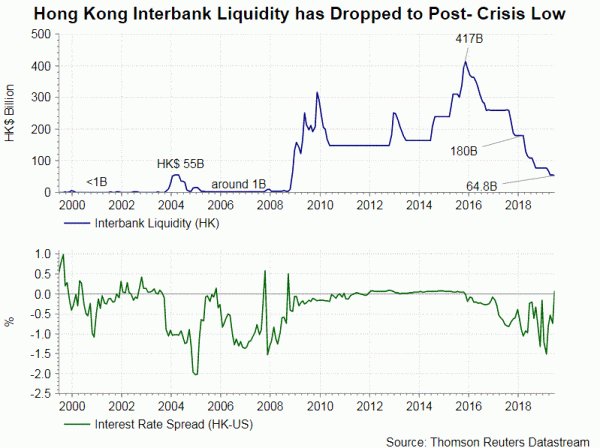Recent spike in HIBOR has sent HIBOR-LIBOR spread to the positive territory, a situation not seen in a decade for both 1-month and 3-month spreads. In our opinion, the upside for HIBOR is limited although it could stay elevated in the near-term due to seasonal factors.
On June 13, both 1-month and 3-month HIBOR (HKD) jumped to the levels not seen since October 2018 sending the rates above the corresponding LIBOR (USD). Despite slight moderation over the past week, both 1-month and 3-month HIBOR have remained elevated. The sudden rally in HIBOR has been coincidental to the deadlock of US-China trade war and escalated political uncertainty in Hong Kong. However, as of now, we view this as mainly a catch-up with LIBOR under the linked exchange rate of HKD.
HKD has been pegged to USD for about three decades at a range of 7.75-7.85. HKMA, the de facto central bank of Hong Kong, allows the exchange rate to float within the range. It would intervene if the exchange rate breaks above (below) the boundary by selling (buying) USD in the market. HIBOR has been trading narrowly below LIBOR for most of the time in history. As HKD approaches the weak side of the trading range, investors would expect HKD to appreciate in the future. Therefore, they are willing to hold HKD although its interest rates are slightly less than those of holding USD.
HKD Less Attractive in Carry Trade
However, the HIBOR- LIBOR spread had widened markedly since 2017 before reaching the most serious level in 1Q19. This derailment from the norm was a result of the massive capital inflow, mainly from China, to Hong Kong in years after the 2007/08 global financial crisis. The abundant interbank liquidity (aggregate balance) diminished the need for commercial banks to raise interest rates, thereby suppressing HIBOR relative to LIBOR.
Widening HIBOR- LIBOR spread in 2018 made HKD an attractive funding currency in carry trade. The resulting capital outflow and selloff in HKD had triggered a number of HKMA interventions for maintaining the peg. As HIBOR increases and HIBOR- LIBOR spread narrows, HKD as a funding currency would become less attractive. This should help reduce the risk of capital outflow.
We believe the upside for HIBOR is limited, although it could continue hovering around the current level in the near-term. The room for further increase in HIBOR is limited as the Fed would likely cut the policy later this year. This could lower LIBOR and hence HIBOR. Despite the fact that HIBOR generally follows LIBOR closely, lower aggregate balance in Hong Kong’s banking system would make HIBOR’s movement more sensitive and volatile to the change in liquidity. Moreover, HIBOR would be affected by seasonal factors. For instance, half- year end (June) cash need could tighten liquidity, squeezing HIBOR higher.















